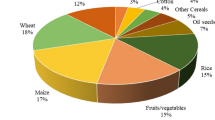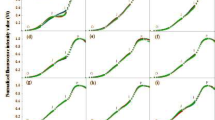Abstract
The flux of nitrous oxide (N2O) from a rice paddy field to the atmosphere was measured at Ryuhgasaki experiment station in Ibaraki Prefecture of Japan by closed chamber method, from the summer of 1992 to the summer of 1993. During the rice-cultivated and flooding periods when methane (CH4) was emitted, no emission or uptake of N2O was measured because the flux values were below the detection limits. After the final water drainage for harvest in August or September, N2O began to emit from the soil surface while the emission of CH4 was stopped, and N2O was emitted continually until the re-flooding day in the following spring. In the first few months after the final water drainage, the N2O flux was in the range of 10–20 µgN/m2/hour, then in the latter several months during the cold season, the N2O flux was less than 10 µgN/m2/hour. The vertical profiles of N2O, CO2 and CH4 concentrations in the plowed layer of the soil down to a depth of 20 cm, were also measured six times in the fallow season. The maximum concentrations of N2O and CO2 were found in the plowed layer in the early period, and which demonstrates that most of the N2O was produced in the plowed layer through nitrification, due to the decomposition of organic matter accumulated in the plowed layer during the rice-growing and water-flooding period. On the contrary, the vertical profiles in the cold season showed a gradual increase in the concentrations of N2O and CO2 in the plowed layer. It clearly indicates that a small amount of N2O was emitted to the atmosphere by diffusion through the plowed layer from the sub-soil layer where a large source of N2O was expected to exist.
Similar content being viewed by others

References
Buresh RJ and Austin ER (1988) Direct measurement of dinitrogen and nitrous oxide flux in flooded soils. Soil Sci Soc Am J 52: 681–688
Buresh RJ, De Datta SK, Samson MI, Phongpan S, Snitwongse P, Fagi AM and Tejasarwana R (1991) Dinitrogen and nitrous oxide flux from ureas basally applied to puddled rice soils. Soil Sci Soc Am J 55: 268–273
De Datta SK, Buresh RJ, Samson MI, Obcemea WN and Real JG (1991) Direct measurement of ammonia and denitrification fluxes from urea applied to rice. Soil Sci Soc Am J 55: 543–548
Lindau CW, DeLaune RD, Patrick WH Jr and Bollich PK (1990) Fertilizer effects on dinitrogen, nitrous oxide, and methane emissions from lowland rice. Soil Sci Soc Am J 54: 1789–1794
Mosier AR, Chapman SL and Freney JR (1989) Determination of dinitrogen emission and retention in floodwater and porewater of a lowland rice field fertilized with 15N-urea. Fert Res 19: 127–136
Smith CT, Brandon M and Patrick WH Jr (1982) Nitrous oxide emission following urea-N fertilization of wetland rice. Soil Sci Plant Nutr 28: 161–171
Tsuruta K, Kanda K and Yagi K (1994) Measurement of trace gas exchange between rice paddy fields and the atmosphere through all seasons. Research Reports of Division of Environmental Planning in National Institute of Agro-Environmental Sciences. No. 10: 43–56 (in Japanese)
Yagi K, Tsuruta H and Kanda K (1994a) Effect of water management on methane emission from a rice paddy field. Research Reports of Division of Environmental Planning in National Institute of Agro-Environmental Sciences. No. 10: 61–71 (in Japanese)
Yagi K, Tsuruta H, Minami K, Chairoj P and Cholitkul W (1994b) Methane emission from Japanese and Thai paddy field. In: Minami K, Moiser A and Sass R (eds) CH4 and N2O, pp 41–54 Yokendo Publishers
Yagi K, Tsuruta H, Kanda K and Minami K (1996) Effect of water management on methane emission from a Japanese rice paddy field: automated methane monitoring. Global Biogeochemical Cycles 10: 255–267.
Author information
Authors and Affiliations
Rights and permissions
About this article
Cite this article
Tsuruta, H., Kanda, K. & Hirose, T. Nitrous oxide emission from a rice paddy field in Japan. Nutrient Cycling in Agroecosystems 49, 51–58 (1997). https://doi.org/10.1023/A:1009739830004
Issue Date:
DOI: https://doi.org/10.1023/A:1009739830004



